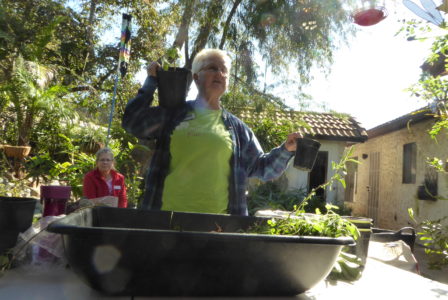Propagation- Part 2:
Asexual Propagation

Anne Murphy educates on propagation, the ways to successfully divide bulbs and plants.
In January Anne Murphy gave a talk on Propagating Plants. Last month I wrote about her description of Sexual Propagation, done by seed. This month will touch on the rest of Murphy’s talk: Asexual Propagation, which is basically cloning. One cuts a piece of the plant and grows it. It comes out identical to its parent. Whereas with seeds, it can be hit or miss.
Murphy says that succulents are the easiest to do. Stick a portion of the plant (with nodes where branches will form) into the ground. There is no need to feed succulents or our native plants. Succulents do best if left to “scab” over the cut or tear before planting. Cacti can be left to scab for a long time. Anne says your success rate will be terrific. However, other plants are not quite as easy.
Just as you do with seeds, you need to prepare a bed. Murphy starts with either with a six-inch pot filled with rich organic potting mix and a bit of Perlite for drainage or with a flat tray about four inches wide and eight inches wide filled with a mixture of the smallest sizes of three parts of Perlite and one part Vermiculite. Using a two by four or a brick, she presses this mixture into the tray. She then pre-moistens whichever material she uses. Don’t waste space or time with six- pack containers or miniature pots. You want to have a pot big enough to hold at least three or four cuttings.
When you are growing from a cutting, there are several rules of thumb. You need vigorous stems (the softer, the easier to propagate. A chrysanthemum will be easier to grow from this method than manzanita.) Side branches may be softer yet still sturdy enough to use. Next you want to take your cutting with at least eight nodes: four nodes will be above the soil line and four below. The nodes are the swellings on the stem or branch where the hormones are. From these come branches or roots, depending on where they are placed. Don’t use the delicate tip. Your cutting should be somewhat sturdy. After you have removed your cutting and chosen the eight-node area you want, remove most of the leaves. If the plant has flowers, remove them. That isn’t where you want the hormones. Cuttings from flowering plants should be taken before the plant forms buds as it first comes out of dormancy.
You need them in the nodes. Dip the portion to be in the ground in a powdered root hormone like Root Tone. Shake off the excess and carefully place the cutting in either of the prepared mixes. Just as you did with seeds, as the plant grows, you will move it into a larger pot, each time replanting with a larger portion of your garden soil to potting soil. This is how you wean your plant. Because Murphy likes native plants, which belong in our not-so-rich nor beautiful earth, the gradual weaning process increases your chance of success. When your cutting is twice as big as it was when you first planted it, it is ready to go into a one gallon pot where it will remain until has plenty of roots.
Murphy cautions against forgetting to label your cuttings. Each pot should only have one variety or species. For labels, cut slats from mini blinds (find them at garage sales), use the back of old plant labels, or use popsicle sticks. Mark labels with an oil-based Sharpie or a pencil. Write the plant’s name, where it came from and the date cut on the label. Two years from now you will definitely need that label. And once it is in a gallon pot, it may need a year or two to grow sufficient roots to survive in your garden.
When the cutting is ready to plant in your garden, dig a hole about twice as big as the pot. Next, up-end the pot carefully. Without disturbing the root ball, set it into the hole. Do not leave any air pockets. Gently but firmly pack the soil against the root ball.
Division is another propagation method. Bulbs and roots can be divided. Murphy showed us an enormous bunch of roots. It was only a portion of the original plant. Again, you carefully dig up the root ball. Do not shake the dirt off it. Take as much as you want and separate it from the bunch. Dig a hole twice the size of your plants’ root, mix a bit of potting soil and Perlite with the garden dirt, and place the part you want in the hole. Cover with dirt mixture packing carefully to avoid air pockets. Water it, and cross your fingers. It should work.
Remember that when you plant bulbs or divided plants, you must plant at the right depth or they won’t bloom. Murphy said she has seen bulbs that made their way to the proper depth when she planted them too shallow, but most bulbs are not that accommodating.
According to Murphy, you will eventually have success. She has successfully rooted one manzanita cutting, which is now quite magnificent. She had many, many failures. Listening to members of the audience, I realized that these propagators are addicted to it. That’s not a bad addiction. It could be worse!
On April 26 we will learn about tricks to create art with succulents. The meeting is from 6 to 8 p.m. at the church at 4070 Jackdaw. Members are free; guests are $10.
Category: Local News







